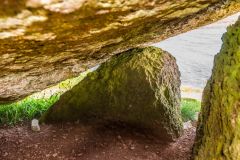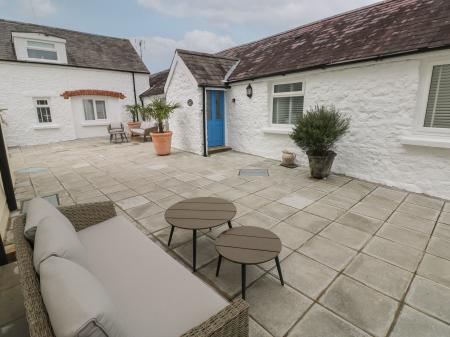
This is an unusual site, as the capstone is supported by the sloping hillside on one end and only partly by three small upright stones. It is so low to the ground that it seems to have grown there organically. This type of chamber is known as 'sub-megalithic', that is, only part of the capstone is supported by upright stones while part rests on the earth or living rock, or is supported by a rock-cut pit.
The relatively small uprights mean the chamber is only about 1 metre high, yet the capstone is huge, projecting out from the hillside some 4 metres, and about 2.5 metres wide and 0.5 metres thick. It seems to point out into the bay like a giant finger. The stones are all local red sandstone.
The inner chamber formed by the capstone is about 0.8m high and is partially below ground level.
What really makes King's Quoit so much fun to visit is the fantastic location overlooking Manorbier Bay. It's the sort of place you just want to sit and watch the world go by. Perhaps that was the point for the Neolithic builders, too?
Do take time to explore the medieval castle and the wonderful early medieval church on the hillside, just inland of the quoit.

Getting There
There is a parking area near the castle, and access to the coast is easy. Follow the Pembrokeshire Coastal Path along the cliffs to the east, and the cromlech is located at the south-east corner of the bay. You can easily make out the cromlech from the beach, about halfway up the hillside.
Alternatively, if you want a slightly longer walk, take the coastal path that runs directly beside the churchyard and follow it across the headland before branching right and descending to the fairly obvious cromlech below you. You can then return to the beach via the lower path to make a very nice circular walk.










